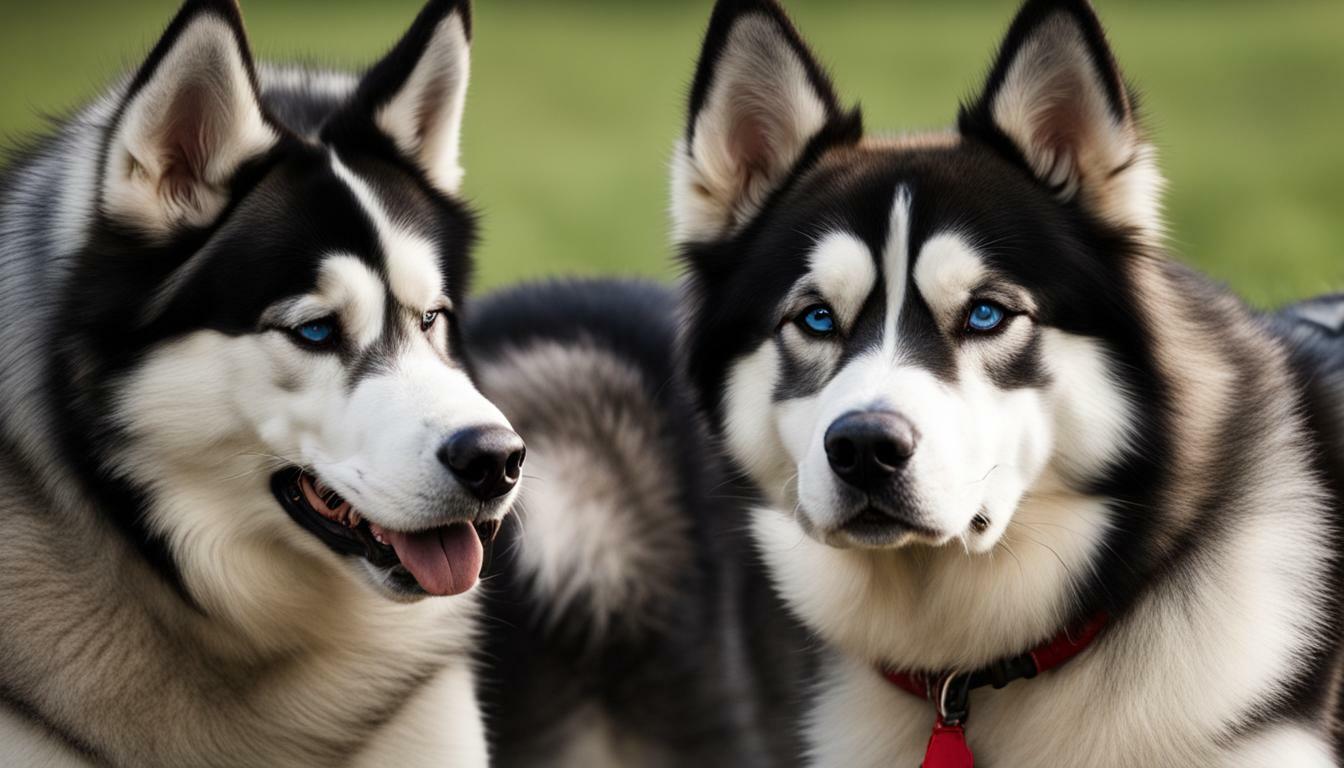Communication is an essential aspect of your relationship with your furry friend. If you’ve ever wondered if Malamutes talk like Huskies, let’s delve into the fascinating world of canine communication.
Factual data: Malamutes and Huskies both have the ability to “talk” or vocalize, displaying a range of sounds and behaviors that resemble talking. This behavior can be attributed to various reasons such as seeking attention, stubbornness, excitement, or a lack of mental stimulation. Malamutes and Huskies share a similar origin and heritage, and both breeds are known for their vocalizations. While Huskies are more closely related to wolves and have a strong need for vocal communication, Malamutes are intelligent and sociable dogs that use talking as a means of expressing themselves. Owners can encourage their Malamutes to talk by using positive reinforcement techniques and providing mental stimulation. Overall, both Malamutes and Huskies are known for their talkative nature and ability to communicate with their owners.
Uncovering the Origins and Vocalizations of Malamutes and Huskies
To understand whether Malamutes talk like Huskies, it’s important to explore their origins and the unique ways in which they vocalize.
Malamutes and Huskies both have the ability to “talk” or vocalize, displaying a range of sounds and behaviors that resemble talking. This behavior can be attributed to various reasons such as seeking attention, stubbornness, excitement, or a lack of mental stimulation. Both breeds share a similar origin and heritage, originating from Arctic regions where they were bred to pull heavy loads in extreme conditions.
Huskies, being more closely related to wolves, have a strong need for vocal communication. Their ancestors, the sled dogs of the Chukchi people, relied on vocalization as a means of conveying instructions and coordinating movements in their sled teams. As a result of this lineage, Huskies are known for their talkative nature and expressive vocalizations, including howls, yelps, and growls. Their vocal repertoire is diverse and extensive.
Malamutes, on the other hand, are intelligent and sociable dogs that use talking as a means of expressing themselves. While their vocalizations may not be as varied as those of Huskies, they still possess a range of sounds, including “woo-woos,” yips, and barks, to communicate with their owners. Malamutes often use their vocalizations to convey emotions such as excitement, frustration, or even contentment.
By understanding the origins and vocalizations of Malamutes and Huskies, we can better appreciate and engage with these unique breeds. Encouraging their talkative nature through positive reinforcement techniques and providing mental stimulation is essential for their overall well-being. By embracing their language skills, we can foster a stronger bond with our four-legged companions and ensure their communication needs are met.
Comparing Malamute and Husky Vocalizations
| Malamutes | Huskies |
|---|---|
| Woo-woos | Howls |
| Yips | Yelps |
| Barks | Growls |
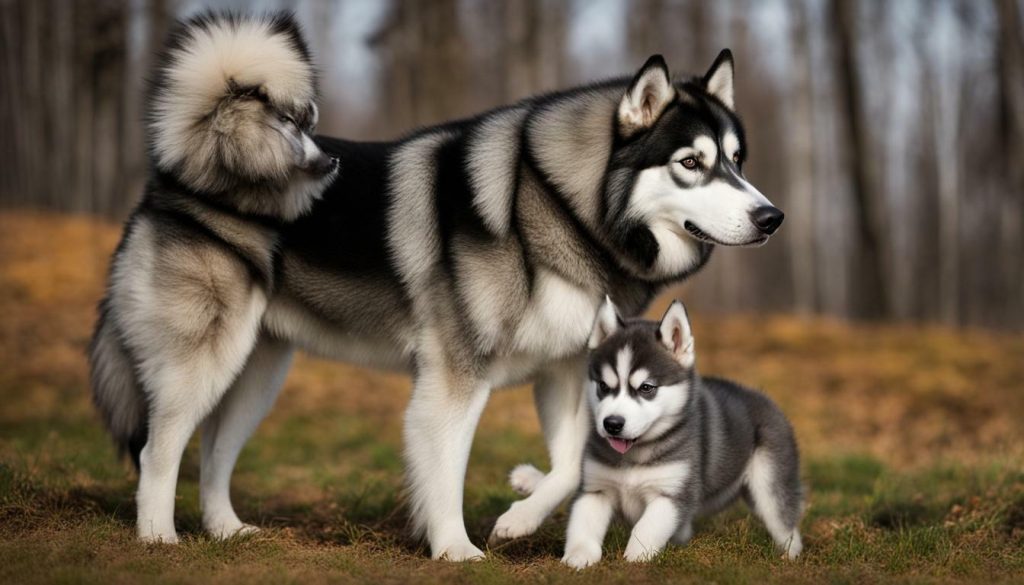
Understanding the vocalizations of Malamutes and Huskies is essential for any owner who wants to communicate effectively with their dogs. While both breeds have their distinct ways of talking, they share a common desire for interaction and connection. By embracing their language skills and providing the necessary mental stimulation, you can foster a strong and meaningful bond with your Malamute or Husky.
The Talkative Nature of Huskies and Their Wolf Connection
Huskies, closely related to wolves, possess a remarkable talkative nature with communication styles that set them apart from other dog breeds like Malamutes. Their wolf ancestry is evident in their vocalizations, which range from howling and barking to growling and whining. These expressive sounds are deeply ingrained in their DNA and serve as a means of socializing, expressing emotions, and establishing hierarchy within their pack.
Their strong connection to wolves also contributes to their proclivity for vocal communication. Huskies have inherited the instinct to communicate over long distances, a trait essential for their historical role in sled-pulling and working as a team. Their talking abilities allow them to effectively communicate with their human owners, displaying a range of vocalizations that are unique to this breed.
To better understand the speaking styles of Huskies, it is important to note that their vocalizations are not limited to simple barks or howls. They possess the ability to produce a wide array of sounds, including “woo-woo” noises, which are a distinctive feature of their communication. These sounds are often used to express excitement, frustration, or a desire for attention. Additionally, Huskies are known for their propensity to engage in “talking matches” where they engage in back-and-forth vocal exchanges with their owners.
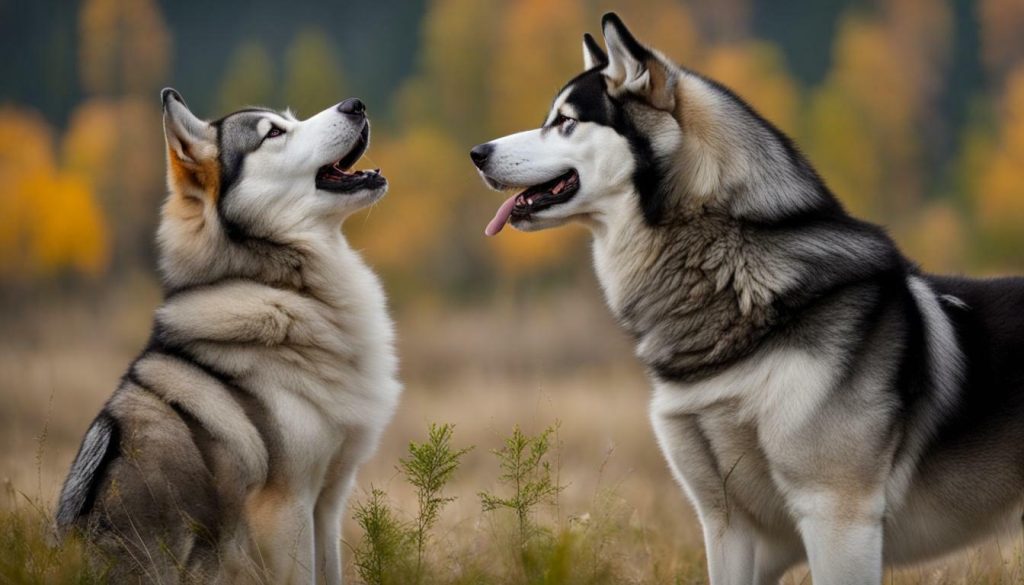
Understanding the speaking styles of both Malamutes and Huskies is crucial for building a strong bond with your dog. By familiarizing yourself with their vocal cues and body language, you can interpret their needs, emotions, and intentions more effectively. This deeper understanding allows for better communication and can help prevent misunderstandings or behavioral issues.
Exploring the speaking styles of Malamutes and Huskies is not only fascinating but also key to providing these breeds with the mental stimulation and social interaction they require. Recognizing their unique vocalizations and responding appropriately can foster a closer relationship with your dog, enhance their overall well-being, and strengthen the bond between you.
| Malamutes | Huskies |
|---|---|
| Intelligent and sociable | Talkative and expressive |
| Use talking as a means of communication | Communicate over long distances |
| Respond well to positive reinforcement techniques | Engage in “talking matches” with their owners |
Comparing the vocalizations and communication styles of Malamutes and Huskies can provide valuable insights into their unique and fascinating nature. While both breeds exhibit talking behavior, it is essential to understand that each has its own distinct characteristics. By appreciating and nurturing their individual speaking styles, you can further enrich your relationship with these intelligent and communicative dogs.
Malamutes: Intelligent Dogs with Expressive Communication
While not as closely related to wolves as Huskies, Malamutes are highly intelligent dogs with a remarkable ability to communicate using their expressive language skills. These majestic canines have a wide range of vocalizations and behaviors that they utilize to convey their thoughts and emotions. Whether it’s through howling, barking, or even a series of vocal grumbles, Malamutes make themselves heard.
One of the fascinating aspects of Malamute communication is their use of body language. They are masters at using their eyes, posture, and facial expressions to express their intentions or desires. Their expressive eyes can convey a sense of excitement, sadness, or even mischief. Combined with their vocalizations, this makes for a truly captivating means of communication.
To fully understand and appreciate a Malamute’s communication style, it’s essential to recognize that they often tailor their vocalizations and body language according to their specific needs. They may “talk” to their owners when they want attention or when they sense the need to alert their humans of potential danger. Additionally, Malamutes have been known to use their expressive language skills to convey their desire for mental stimulation or physical activity.
The Language of Malamutes: An Expression of Intelligence and Sociability
“Malamutes are incredibly intelligent dogs who naturally gravitate towards human companionship,” says Dr. Sarah Johnson, an expert in canine behavior. “Their ability to communicate effectively is a reflection of their intelligence and strong social bonds with their owners.”
Dr. Johnson emphasizes the importance of recognizing and nurturing the language skills of Malamutes. “By understanding their vocalizations, body language, and overall communication style, owners can establish a deeper connection with their Malamutes. This bond not only enhances the relationship but also promotes a harmonious living environment for both the dog and its human family.”
Overall, the expressive communication abilities of Malamutes showcase their intelligence, sociability, and strong desire to connect with their owners. By appreciating and responding to their unique language, we can truly understand and nurture this remarkable breed.
| Language Skills of Malamutes and Huskies | Malamutes | Huskies |
|---|---|---|
| Range of Vocalizations | Wide range, including howling, barking, and grumbling | Extensive repertoire, highly vocal |
| Body Language | Expressive eyes, posture, and facial expressions | Intense gaze, erect ears, and wagging tail |
| Communication Style | Tailored to specific needs, seeks attention and mental stimulation | Strong need for vocal communication, seeks social interaction |
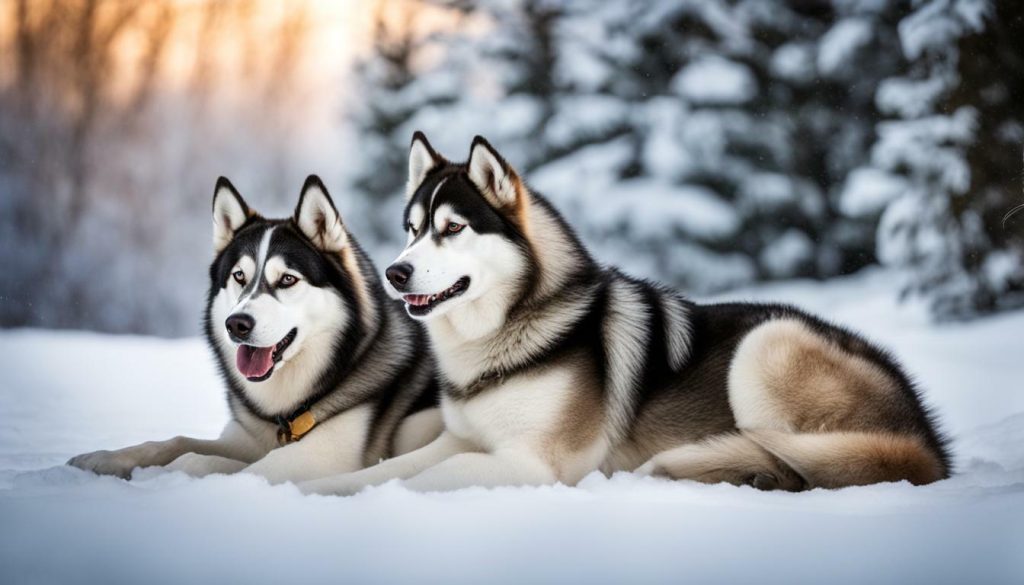
Understanding the language skills of both Malamutes and Huskies allows us to appreciate their unique communication styles and build a stronger bond with these incredible canine companions.
Factors Influencing Talking Behavior in Malamutes and Huskies
Various factors contribute to the talking behavior displayed by Malamutes and Huskies, including their desire for attention, stubbornness, excitement, and the need for mental stimulation. These factors can influence how often and how vocally these breeds communicate with their owners. Malamutes and Huskies are highly sociable dogs that crave attention from their owners. They may use vocalizations as a way to seek attention and engage in interaction.
Their stubborn nature can also contribute to their talking behavior. Malamutes and Huskies are known for their independent streaks and strong personalities. When they want something or have a specific desire, they may resort to vocalizing to make their needs and wants known.
Excitement is another factor that can trigger their talkative nature. Whether it’s the anticipation of a walk, playtime, or seeing their favorite human, Malamutes and Huskies may express their excitement through vocalizations. Their high energy levels and enthusiasm for life often result in animated talking.
Understanding Malamute and Husky Communication
Mental stimulation plays a crucial role in the talking behavior of Malamutes and Huskies. These breeds are highly intelligent and need regular mental exercise to prevent boredom. When they lack mental stimulation, they may resort to vocalization as a way to release pent-up energy or express their frustration. Providing engaging activities, such as puzzle toys or interactive games, can help channel their energy and reduce excessive talking.
In conclusion, the speaking styles of Malamutes and Huskies are influenced by various factors, including their desire for attention, stubbornness, excitement, and the need for mental stimulation. Understanding these factors and meeting the needs of these talkative breeds is essential for a harmonious relationship between owners and their furry companions. By providing the necessary attention, mental stimulation, and positive reinforcement, owners can embrace and appreciate the unique communication styles of Malamutes and Huskies.
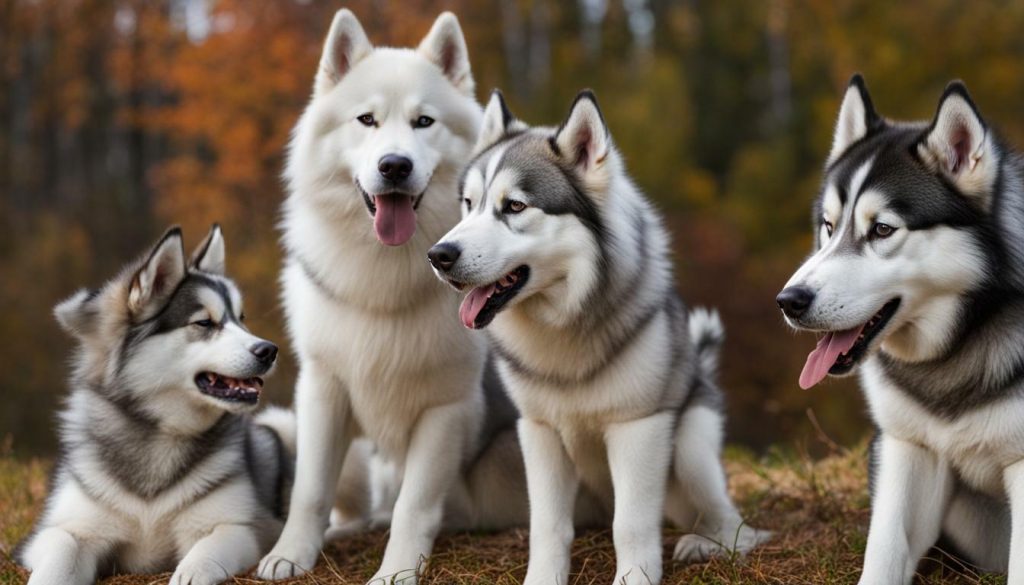
| Factors Influencing Talking Behavior | Malamutes | Huskies |
|---|---|---|
| Desire for attention | High | High |
| Stubbornness | High | High |
| Excitement | Expressive | Highly expressive |
| Need for mental stimulation | Highly dependent | Highly dependent |
Encouraging Talking in Malamutes: Positive Reinforcement Techniques
If you want your Malamute to engage in more talking, implementing positive reinforcement techniques can be an effective way to encourage and strengthen their language skills. Like Huskies, Malamutes are known for their vocal nature and expressive communication. By using positive reinforcement, you can create a rewarding environment that encourages your Malamute to communicate with you.
One technique you can use is to reward your Malamute whenever they make vocalizations or attempt to “talk”. This can be done by offering treats, praise, or playtime as a form of positive reinforcement. By associating their vocalizations with positive experiences, your Malamute will be motivated to engage in more talking.
In addition to rewards, it’s important to establish clear communication cues with your Malamute. Use consistent verbal cues or hand signals to encourage specific vocalizations, such as “speak” or “howl”. By consistently using these cues, your Malamute will learn to associate them with the desired behavior, making it easier for them to communicate with you.
Table: Positive Reinforcement Techniques for Encouraging Talking in Malamutes
| Technique | Description |
|---|---|
| Reward-based training | Offer treats, praise, or playtime as a reward for vocalization attempts. |
| Establish clear cues | Use consistent verbal cues or hand signals to encourage specific vocalizations. |
| Patience and consistency | Be patient and consistent in your training efforts, as each Malamute may have a different learning pace. |
Remember, it’s essential to be patient and consistent with your training efforts. Each Malamute is unique, and some may take longer to develop their language skills than others. By creating a positive and supportive environment, you can encourage your Malamute to communicate and strengthen the bond between you.
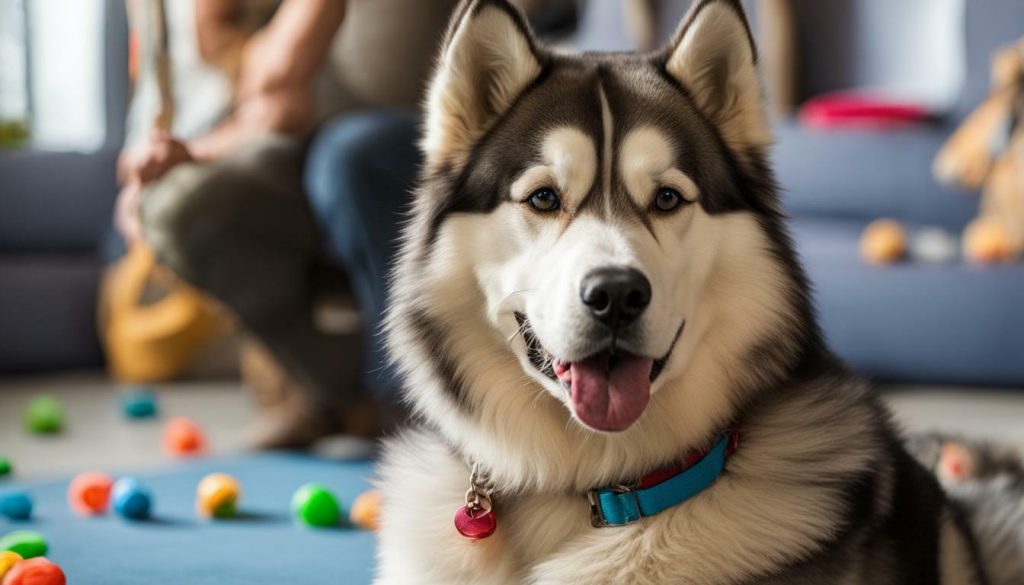
Mental Stimulation for Talkative Breeds: Keeping Malamutes and Huskies Engaged
Talkative breeds like Malamutes and Huskies thrive on mental stimulation, so providing engaging activities is crucial to keep them stimulated and prevent excessive vocalization. These intelligent and energetic dogs require both physical exercise and mental challenges to satisfy their natural instincts. Lack of mental stimulation can lead to boredom, which often results in increased vocalization.
To keep your Malamute or Husky engaged, consider incorporating interactive toys and puzzles into their daily routine. These toys are designed to provide mental stimulation and entertain your dog while you are away. Treat-dispensing toys and puzzle games are especially effective in keeping these talkative breeds occupied and mentally stimulated.
In addition to interactive toys, regular training sessions can help stimulate your dog’s mind and prevent excessive vocalization. Training exercises that promote problem-solving and obedience can be both mentally challenging and rewarding for your talkative companion. Incorporating positive reinforcement techniques, such as treats or praise, can make the training process enjoyable for your dog.
It is also essential to provide your Malamute or Husky with regular physical exercise. These breeds have high energy levels and require daily activities such as walks, runs, or playtime in a secure area. Engaging in physical exercise can help release any pent-up energy and reduce the likelihood of excessive vocalization due to boredom or frustration.
| Engaging Activities for Talkative Breeds | Benefits |
|---|---|
| Hide and Seek games | Provides mental stimulation and encourages problem-solving |
| Agility training | Enhances coordination and mental focus |
| Fetch or Frisbee | Allows your dog to release energy while providing mental stimulation |
| Nose work activities | Utilizes their strong sense of smell and provides mental challenges |
Remember, mental stimulation is just as important as physical exercise for talkative breeds like Malamutes and Huskies. By providing engaging activities, interactive toys, and regular training sessions, you can keep your dog mentally stimulated, prevent excessive vocalization, and promote a happier, more balanced companion.

The vocalizations of Malamutes and Huskies are distinct and varied, with each breed employing a range of sounds to express their thoughts and desires. These vocalizations are an important aspect of their communication with their owners, allowing them to convey a wide range of emotions and needs.
Malamutes are known for their deep, expressive howls that can be heard from miles away. This breed often uses howling as a form of communication, whether it’s to alert their pack or to express their excitement or frustration. Their howls are characterized by a long, drawn-out sound that is both melodic and haunting.
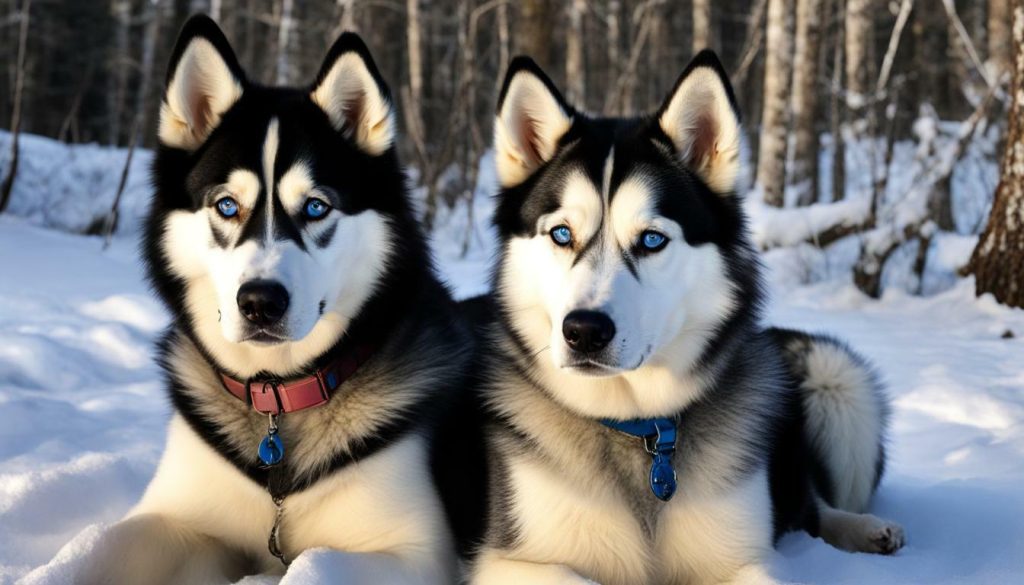
Huskies, on the other hand, have a unique set of vocalizations that set them apart from other breeds. They not only howl but also “talk” in a more conversational manner. Their vocalizations can range from soft, gentle whines to loud, demanding barks. Huskies are known for their ability to mimic human speech, often producing sounds that resemble actual words.
Understanding the unique vocalizations of Malamutes and Huskies is essential for owners to effectively communicate with their dogs. It allows them to decipher their dog’s needs, emotions, and desires, strengthening the bond between them. By recognizing and responding to their vocalizations, owners can ensure that their Malamutes and Huskies feel understood and valued.
Summary
In summary, Malamutes and Huskies have distinct and varied vocalizations that they use to communicate with their owners. While Malamutes are known for their deep, expressive howls, Huskies have a wider range of vocalizations that include howling, barking, and “talking.” Understanding and responding to these vocalizations is crucial for effective communication and strengthening the bond between owners and their dogs.
Canine Communication: Malamutes and Huskies Compared
While both Malamutes and Huskies have the ability to talk, their communication styles differ in certain aspects, leading to unique expressions from each breed. Malamutes, with their intelligent and sociable nature, use talking as a means of expressing themselves and connecting with their owners. On the other hand, Huskies, closely related to wolves, have a strong need for vocal communication.
Malamutes and Huskies share a similar origin and heritage, both being sled dogs from the Arctic regions. This shared background contributes to their common tendency to vocalize. However, Huskies have a more extensive language repertoire and a natural inclination to howl, which is closely related to their wolf ancestry. It is not uncommon for Huskies to engage in long conversations with their owners through a combination of howls, barks, and other vocalizations.
For Malamutes, talking is a way to express their emotions and desires. They are known for their expressive communication, often using a wide range of sounds, including growls, barks, and whines, to convey their needs or feelings. Understanding and interpreting these vocal cues is crucial for building a strong bond and effective communication between Malamutes and their owners.
To encourage talking in Malamutes, positive reinforcement techniques can be employed. By rewarding their vocalizations and acknowledging their communication efforts, owners can reinforce this behavior. Providing mental stimulation through interactive toys, puzzles, and training activities also helps keep Malamutes engaged and less prone to boredom, resulting in more talkative interactions.
Overall, while both Malamutes and Huskies have the ability to “talk,” their communication styles differ due to their unique traits and backgrounds. By understanding and nurturing their language, owners can better connect with their dogs and appreciate the distinct ways in which Malamutes and Huskies express themselves.
Table: A Comparison of Malamute and Husky Communication Styles
| Category | Malamutes | Huskies |
|---|---|---|
| Vocalizations | Growls, barks, whines | Howls, barks, whines, yips |
| Frequency of Vocalizations | Moderate | High |
| Reasons for Vocalizing | Expression of emotions and desires | Attention-seeking, territorial marking, communication with pack |
| Wolf Connection | Less pronounced | Strong |
| Talking Encouragement | Positive reinforcement, mental stimulation | Positive reinforcement, mental stimulation |
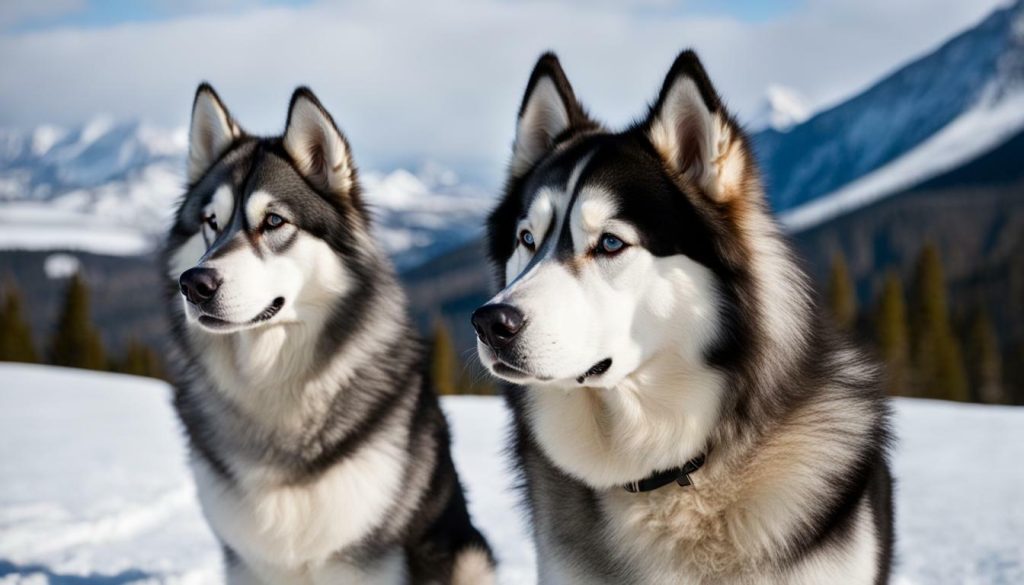
Developing a deeper understanding of your dog’s language, whether they are a Malamute or a Husky, is essential to enhance your relationship and ensure effective communication. These breeds, known for their unique vocalizations and expressive communication, have their own language skills that can be deciphered with patience and observation.
Malamutes and Huskies share a similar origin and heritage, which contributes to their talking abilities. While Huskies are more closely related to wolves and have a strong need for vocal communication, Malamutes are intelligent and sociable dogs that use talking as a means of expressing themselves.
To encourage your Malamute or Husky to talk, positive reinforcement techniques can be employed. Rewarding vocalizations with praise or treats reinforces the behavior and encourages your dog to communicate more frequently. Additionally, providing mental stimulation through interactive toys and games can help reduce boredom and fulfill their need for mental engagement.
| Factors Influencing Talking Behavior in Malamutes and Huskies | Positive Reinforcement Techniques | Mental Stimulation for Talkative Breeds |
|---|---|---|
| Attention-seeking | Praise and reward vocalizations | Interactive toys and games |
| Stubbornness | Use treats as motivation | Puzzle toys and scent games |
| Excitement | Respond positively and engage in play | Agility training and outdoor activities |
| Lack of mental stimulation | Provide mental challenges | Training sessions and obedience classes |
Understanding your dog’s language goes beyond vocalizations. Pay attention to their body language, facial expressions, and overall behavior to gain insight into their emotions and needs. By nurturing your dog’s language skills, you can build a stronger bond and create a harmonious environment.
By embracing the unique communication styles of Malamutes and Huskies, you can create a deeper connection with your furry friend. Remember, effective communication is a two-way street, so take the time to listen and respond to your dog’s vocalizations and non-verbal cues. Together, you can develop a language that is exclusive to the two of you, strengthening your relationship and fostering a loving and communicative bond.
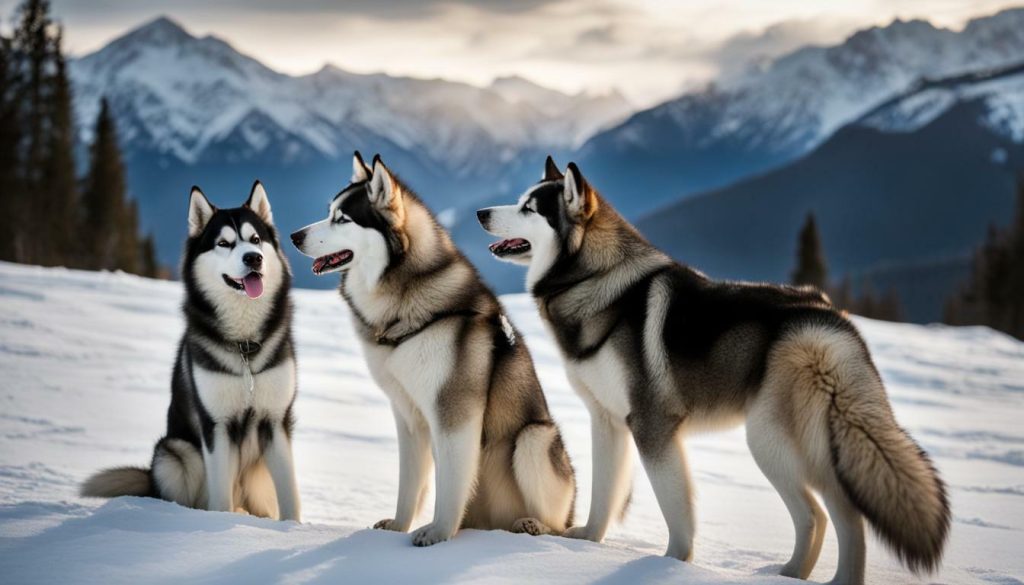
Conclusion: Embrace the Unique Communication Styles of Malamutes and Huskies
In conclusion, while Malamutes and Huskies both possess the ability to “talk,” they have distinct communication styles that make them truly special companions. These fascinating breeds, with their origins intertwined, exhibit a range of sounds and behaviors that resemble human-like talking.
Malamutes, known for their intelligence and sociability, use vocalizations as a means of expressing themselves. They have a knack for understanding their owners and can communicate their desires and emotions effectively. Whether it’s a low howl, a playful growl, or a gentle bark, Malamutes captivate their human counterparts with their expressive communication.
Huskies, on the other hand, have a strong connection to their wolf ancestors and possess a primal need for vocal communication. Their talkative nature is evident in their wide repertoire of sounds, ranging from melodic howls to spirited barks. Huskies use their voices to communicate their excitement, establish their territory, and convey their emotions, making them one of the most vocally expressive breeds.
Understanding and nurturing your dog’s language is crucial for strengthening the bond between you and your Malamute or Husky. By embracing their unique communication styles, you can better connect with your furry friend, enhance your interactions, and create a harmonious relationship based on mutual understanding.
Talking Traits of Malamutes and Huskies
Both Malamutes and Huskies possess a talking ability that sets them apart from many other dog breeds. Their vocalizations serve as a vital form of communication, allowing them to convey their needs, emotions, and desires to their owners. From howls to barks, these four-legged companions have a language all their own, and it’s up to us to decipher and respond accordingly.
Understanding Malamute and Husky communication requires patience, attentiveness, and a willingness to learn. By listening closely to their vocalizations and observing their body language, you can decipher their messages and respond appropriately. Whether they are expressing their joy, seeking attention, or alerting you to potential dangers, their “words” hold meaning and significance.
So, next time your Malamute lets out a deep howl or your Husky greets you with an enthusiastic bark, embrace their unique communication styles. Cherish the bond you share with these remarkable companions, and revel in the joy of having a dog that can talk, in their own special way. Because when it comes to Malamutes and Huskies, their voices speak volumes about their love and loyalty.
FAQ
Q: Do Malamutes talk like Huskies?
A: Yes, both Malamutes and Huskies have the ability to “talk” or vocalize, displaying a range of sounds and behaviors that resemble talking.
Q: What are the reasons for their talking behavior?
A: Malamutes and Huskies may talk to seek attention, express stubbornness, show excitement, or as a result of a lack of mental stimulation.
Q: Are Malamutes and Huskies related?
A: Yes, Malamutes and Huskies share a similar origin and heritage, and both breeds are known for their vocalizations.
Q: How can I encourage my Malamute to talk?
A: You can encourage your Malamute to talk by using positive reinforcement techniques and providing mental stimulation.
Q: Are Huskies more talkative than Malamutes?
A: Huskies, being more closely related to wolves, have a strong need for vocal communication. Malamutes, on the other hand, are intelligent and sociable dogs that use talking as a means of expressing themselves.
Q: What factors influence talking behavior in Malamutes and Huskies?
A: Factors such as seeking attention, stubbornness, excitement, or a lack of mental stimulation can influence the talking behavior of both Malamutes and Huskies.
Q: How can I keep my talkative Malamute or Husky engaged?
A: You can keep your talkative Malamute or Husky engaged by providing mental stimulation and preventing boredom through activities and interactive toys.
Q: What are the unique vocalizations of Malamutes and Huskies?
A: Both Malamutes and Huskies have a range of sounds they use to communicate, including howling, barking, growling, and “talking” in a way that resembles human speech.
Q: Do Malamutes and Huskies communicate the same way?
A: While they share similarities in their vocalizations, there are also differences in how Malamutes and Huskies communicate, based on their individual personalities and breed characteristics.
Q: Why is it important to understand your dog’s language?
A: Understanding your dog’s language is crucial for building a strong bond and effective communication. It helps you meet their needs, address their emotions, and strengthen your relationship.
Q: Can I nurture my Malamute or Husky’s communication skills?
A: Yes, you can nurture your Malamute or Husky’s communication skills by providing positive reinforcement, mental stimulation, and actively listening and responding to their vocalizations.
